Vince’s Pizza
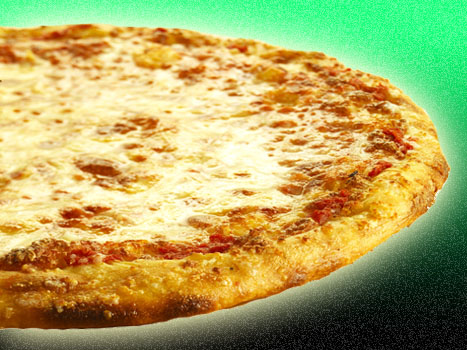
Vince’s Pizza was located on Westwood Boulevard about three blocks north of Santa Monica Boulevard. That’s a generic image above, not a photo of an actual Vince’s Pizza. I doubt any memorabilia exists of the place and as you’ll see, I don’t know much about it. It was the place my family got pizza in the sixties and it was pretty good pie. They had a drive-thru window but I don’t recall my father ever actually driving-thru.
Vince’s went away some time in the early seventies, replaced by a drive-thru dry cleaner. Two things did it in. One was a sudden boom in pizza places. Once upon a time, there were so few of them that people actually went to Piece O’ Pizza, which served very poor pizza. For those who knew what pizza could/should be, Vince’s was a godsend. It was the only place to get a quick, good take-out pizza for miles around…and then, one day when there were others, it wasn’t. But there was another, obvious reason for Vince’s success when it was a bustling business establishment.
Located right nearby — at the intersection of Santa Monica and Westwood Boulevards — there were three (at times, four) huge liquor stores. It was like the Liquor Store Capital of the World on those corners…and people sometimes wondered why they were all congregated there. After all, it’s not like one liquor store sells entirely different liquor than another liquor store. Why so many competitors all bunched together?
The answer is that once upon a time, there was a law that prohibited the sale of beer, wine or spirits within a certain distance of the U.C.L.A. campus and therefore the student housing. The intersection of Westwood and Santa Monica was just outside that distance.
Most nights but especially Saturday, those three or four stores were packed with students. If there had been ten stores there, they all would have done good business. And what did all those students do after they’d picked up beer and booze and were headed back to the frat house? They drove through Vince’s and picked up a pile of pizzas!
My parents learned not to brave Vince’s on a Saturday or even a Friday night. Other evenings, if you went early enough, were fine. But one Saturday night I recall, we phoned in to order a pizza that we’d come pick up and the lady on the phone basically told us not to bother. “We’re running at least an hour behind,” she said. “Our ovens can only cook so many pizzas at one time.” We took her advice and went in the other direction for Chinese.
The law forbidding alcohol from being sold closer to campus was repealed and, of course, other pizza places opened — including, shrewdly, one at the corner of Santa Monica and Westwood — so Vince’s lost most of its advantages. All it had to offer was great pizza and there were a lot of places you could get one of those in the area. And maybe, now that I think of it, it wasn’t so great. It was just greater than the pizza at Piece O’ Pizza, which wasn’t hard to be. My mother could achieve it with a Chef Boyardee mix.
Junior’s Delicatessen II
The original Junior’s Delicatessen opened near the intersection of Pico and Westwood in West L.A. in 1959. As explained here, it was a small operation run by the Saul Brothers that mainly sold corned beef and other deli food to go. But they had a handful of tables and if you wanted to have a sandwich there, one of the brothers would make it and bring it to your table. It was on Pico, a few blocks east of Westwood.
In 1967, they moved to a new building that was more of a restaurant on Westwood. Almost instantly, Junior’s became one of great local success stories for that kind of business. I was a regular customer but I never found the place outstanding. The corned beef wasn’t as good as Art’s. The potato salad wasn’t as good as Nate ‘n Al’s. The chicken soup wasn’t as good as Canter’s and so on. A deli doesn’t have to do all those things well but it ought to do one thing better than everyone else in town. If Junior’s did, I never ordered it. (I feel the same way about Factor’s and Jerry’s, though I’m sure commenters here can tell me of many things they’ve loved at all these places.)
What Junior’s had going for it was a good, friendly feel and a great location. If you had to meet a friend or business associate for lunch in that area, it wasn’t merely the best choice. It was darn near the only one. So I went there often and was never unhappy, except sometimes with the bill or the parking lot. And it did have the main stamp of approval that a deli has to have in Los Angeles: You could sometimes spot Mel Brooks eating there.
Junior’s was such a fixture of the neighborhood that it came as a shock when its closure was announced in December of 2012. It closed the last day of the year. What happened? It depends on who you ask.
Marvin Saul, who founded and ran Junior’s, died near the end of 2011 and control of the business passed to his sons, David and John. In a newspaper article, David blamed their landlords who were trying to raise the rent and were “not willing to bend” on “a number that we can’t give.” He cited rising food costs. In response, the landlords (a firm called Four Corners Investment Co.) blamed the sons. A spokesperson said that they’d had an excellent working relationship with Marvin Saul and had actually lowered the rent below what Junior’s was contractually obligated to pay, hoping that a declining business could turn around. When it came time to renew the lease for 2013, the two sides were unable to agree on a number. The Four Corners people suggested that the sons simply did not have the management skills of the father and that may be so. It may also be so that the Four Corners folks saw an opportunity to bring in a tenant with better prospects and a willingness to pay the full rental value of the property.
Given that I often felt the food was overpriced and not as good as it should have been, I’m inclined to think that Junior’s best days were in the past. But somehow, maybe because it was a part of my world for so long, I already miss the place and hope that reports of it reopening somewhere else will prove true. If they’d gotten a cut of every business deal made at their tables, the place would still be the gold mine that it was for Sauls in the late sixties through about the nineties.
Wil Wright’s
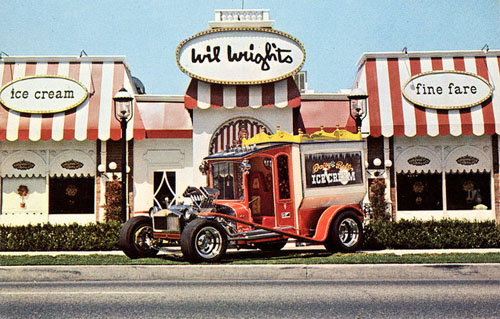
Wil Wright’s was a chain of ice cream parlors that dotted the Southern California landscape up until the mid-seventies. There was one in Beverly Hills at the corner of Beverly Drive and Charleville, and another in Westwood Village at the corner of Glendon and Lindbrook. (There were others but those were two I frequented.) They were the perfect place to take a date after the movie. The delicate pink and red decor and little marble tables and wire-frame chairs made you feel like you were seated inside a Valentine’s Day card.
I believe there was one over on San Vicente in the Pacific Palisades area. I recall stopping in there one night after a movie with a date and the place was short-handed. There were about twelve tables and all the vacant ones still had the remnants of the previous diners…dirty dishes, slightly-filled glasses, etc. We sat at one for quite a while before a waitress came over to us…and when she did, she began scolding us for sitting at a non-clean table. As if lecturing the entire room, she began ranting about, “Why do people insist on sitting down at dirty tables before we have a chance to clear them?” Well, maybe because there was nowhere else to sit or stand and you were taking your own sweet time about cleaning the tables. I think we got up and went to find a Baskin-Robbins rather than to let that person wait on us.
But usually, a Wil Wright’s was a fun place to be. I seem to recall that my dates would always order the banana split while I wondered about the Freudian implications of their orders. I would either have a milk shake or a dish of Wil Wright’s unique orange ice which resembled frozen orange juice more than any orange ice or sorbet I’ve ever had anywhere else.
It was excellent ice cream made (apparently) on what I’m told is the Haagen-Dazs principle of ice cream: Make the same ice cream as every0ne else but ratchet up the sugar and butterfat content. The L.A. Times at one point did an article on local ice cream parlors and suggested that Wil Wright’s product had a notably higher calorie content than, say, the 10-cent cones at your neighborhood Thrifty Drug Store…also darned good places to eat ice cream if you just wanted a cone. I wonder if that harmed sales at Wil Wright’s and perhaps contributed to the chain’s demise. There is still a Wil Wright’s brand of ice cream sold in some stores — perhaps not the same recipe — but I think the parlors are all gone.
This is a scan from a menu I found on eBay. I have no idea of the year. There was also a faded insert page with ditto printing listing sandwiches for 35 cents each…
Webster’s
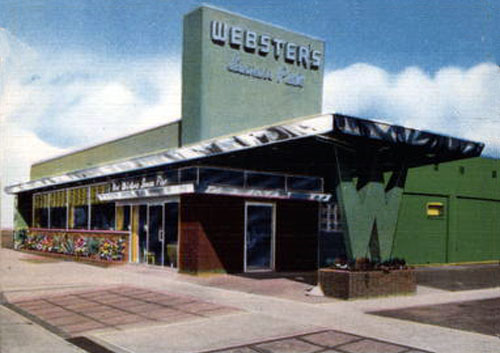
I don’t know much about Webster’s Restaurants, other than that a man named Dick Webster opened several of them around Los Angeles and that he boasted of serving the best lemon pie in the world. The one in the picture above was located at 270 So. La Cienega Blvd. and most of their ads said it was Beverly Hills but I think it was actually on the cusp. There’s a restaurant called Boss Sushi at that address now.
My family and I occasionally went to one on Pico Boulevard a few blocks east of Overland. The food was pretty simple — burgers, roast beef, chicken, stuff like that — but the menu and the waitresses implored you to save room for some of that world famous Webster’s lemon pie. I tried it one time and didn’t see what all the fuss was about. Seemed like pretty standard lemon pie to me, about the same as you got at any restaurant. But a reputation can be a funny thing…
Sambo’s
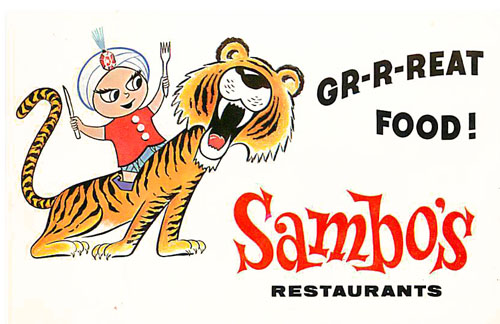
Someone I worked with once said that the only tragedy of the civil rights movement of the sixties was in the demise of Sambo’s Restaurants. A Sambo’s was like an IHOP, which then was more often called an International House of Pancakes. They did a good breakfast business selling pancakes, then became a more traditional coffee shop for later meals in the day.
The chain, which at one point involved some 1,200 outlets, was named for its two founders, Sam Battistone and Newell “Bo” Bohnett…but the amalgam of their names also had another meaning and it changed over the years. You all remember the children’s story of the little boy named Sambo who was chased by tigers and…well, I don’t remember it all that well. Something about the tigers running themselves ragged and turning into melted butter. I never quite understood the biology involved in that but Li’l Sambo took the liquified tiger home and put it on his pancakes. So when people saw the name “Sambo,” they thought of pancakes, which is why it was a good name for a place that served them. Or at least it was when the first Sambo’s was opened in 1957 in Santa Barbara.
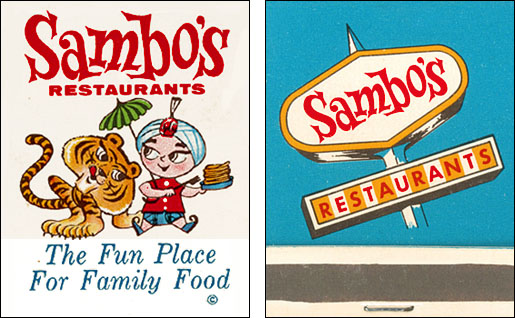
But years later, a name like Sambo — and the accompanying caricature of Sambo, himself — came to denote an ugly racial image. Sambo started out in an 1899 book by Helen Bannerman as a native of India. She called him Little Black Sambo and in later revisions and publications of the story, he fluctuated between Indian and Negroid. Aware that the black version of Little Black Sambo alienated many, the restaurant chain made him more inarguably Indian and when that didn’t change perceptions, they made him Caucasian and tried to change his name and the name of the entire chain to Sammy’s. It didn’t take and by 1985, the once-flourishing chain was in bankruptcy. The original, located in Santa Barbara, is still open (though only for breakfast and lunch) and that’s about it.
Qualitatively, I recall Sambo’s as being about the same as an IHOP, which put them about a half-notch above a Denny’s. I think many of them became Denny’s which for a restaurant is some kind of shameful demotion. As if the chain hadn’t already been embarrassed enough by the controversy about its very name.
Hamburger Hamlet

There are still a few Hamburger Hamlets around: One in Pasadena, one in Sherman Oaks, a new one over on Larchmont and ones in Virginia and Maryland. Still, I think of the ones that were in Beverly Hills and Westwood Village as “my” restaurants and since they’re gone, I can put them in this section. Also in 2011, they closed the one on Sunset near Doheny that was a favorite of many. For the last few years of his life, Dean Martin (who lived not far away) would be in there almost every night and it was said that he welcomed fans to just sit down with him and chat. I kept thinking I oughta go up and see if that was really so but I never got around to it.
When that one on Sunset closed, a number of articles claimed it was the original location. Not true. The first Hamburger Hamlet which opened in 1950 was indeed on the Sunset Strip but farther east. It was at 8931 Sunset, not far from where the Whisky a Go Go nightclub w0uld later flourish for a time.
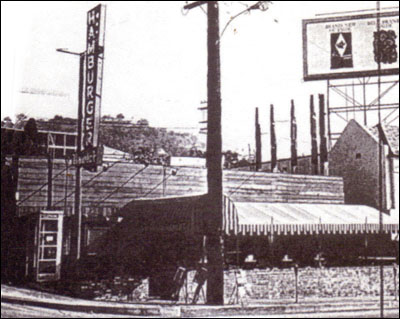
The original location
The Hamlet was the invention of a Hollywood costumer named Marilyn Lewis and her husband, Harry. Harry was an actor, perhaps best remembered for his role in the Humphrey Bogart film, Key Largo. The way the story goes, they opened the first one with all their savings — about $3,000 or $3,500 depending on which account you read. That opening was just before Halloween of 1950 and when they were about to open the doors, they discovered they couldn’t cook. The gas hadn’t been turned on and they were so tapped out that they couldn’t afford to pay the deposit and couldn’t afford to not open on schedule. Marilyn got in touch with a gas man and struck an under-the-table bargain: If he’d come over and turn them on anyway, he could eat there for free as long as they were in business. He did both these things.
The original idea was to open an actors’ hangout but the place quickly caught on with folks of all different vocations and other outlets quickly followed. They made a great flame-broiled burger and while you could order it with any of about a dozen configurations (toppings, add-ons, etc.), I thought the plain, unadorned version was a work of art. It came in a little plastic basket with a handful of potato chips and it was just the perfect lunch. If I was there at dinner, I’d usually order the same thing but with a cup of soup…usually their rich lobster bisque.

Wall signs at the original location.
There were other great things on the menu that came along later. As they expanded, they expanded well beyond burgers. The rotisserie chicken was particularly exquisite. But it was difficult to go to Hamburger Hamlet and not order a hamburger.
Our family went once or twice a month to one of the two Hamlets then in Beverly Hills…and later, when one closed down, we gave all our patronage to the other. It was said that the Hamlet was the first restaurant in that city that actively hired blacks as food servers. My father told me that, I think. He once said he wouldn’t want to give his business to an establishment that didn’t, and I admired him for that view.

I also have two vivid memories of the Hamburger Hamlet that was in Westwood — on Weyburn, more or less where a Jerry’s Famous Deli is now situated. One is of lunching there just before my mother took me to see Bambi at the Village Theater, right around the corner, in 1957. Over my Hamlet burger, I received cautionary words about not getting too upset if and when Bambi’s mother was killed in the movie we were about to see. I believe I said something like, “I won’t. Could I have some more ketchup?”
The other memory is of taking my first date there. Her name was Karen and we ate burgers at the Hamlet in advance of heading down the street to a revival house that was showing the W.C. Fields movie, The Bank Dick. As we were sitting there in the restaurant, Karen told me she was having a very good time being out with me but said something about how I shouldn’t expect anything more than a good-night kiss. I believe I said something like, “I won’t. Could I have some more ketchup?”
UPDATE: The Hamlet on Van Nuys Boulevard is back in business, thanks to the management of Killer Shrimp investing in the place. I’d love to see it make a big comeback but I recently went to the reopened place and was very disappointed. I had a hamburger that was nowhere near the old standard and just plain not very good…and I thought, “Well, if they can’t get that right…” If it remains open and thriving for a while and I hear approving things from others, I’ll probably give it another chance because I did love the old chain and would love to see it back in all its glory. But they have to do more than just offer the same name and menu in the same room.
The Brown Derby
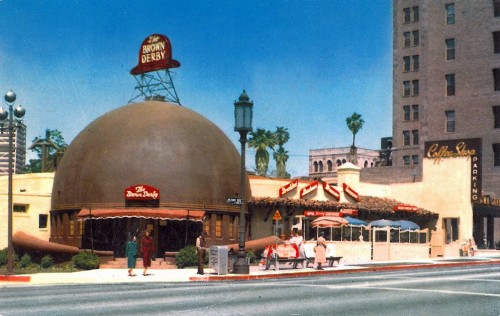
The one on Wilshire near the Ambassador Hotel
At one point, there were several of them in Los Angeles but only one (the one on Wilshire opposite the Ambassador Hotel) was constructed so that when you walked in the front door, it looked like you were walking into a giant hat.
That was the original Brown Derby, which opened on Valentine’s Day of either 1926 or 1929 (accounts differ) and moved one block away in 1937. The other main locations were (1) near Hollywood and Vine, (2) near Wilshire and Rodeo Drive in Beverly Hills, and (3) at Los Feliz Boulevard and Hillhurst in the Los Feliz area. There were also a few short-lived ones in other spots. All served mostly American fare in a semi-plush manner with very attentive service.
Apart from the gimmick of the name and pretty good food, they had two things going for them. One was the Cobb Salad, which was invented at the Brown Derby, which was owned by the Cobb family. As the delicacy caught on in other eateries, there was much publicity as to where it had begun, and many people wanted to go and try the original. Many people also wanted to dine where the stars ate, and that was an even better reason to dine at the Derby. Like many restaurants where the big attraction is celebrity clientele, the proprietors advertised their famous patrons by covering the walls with their caricatures.
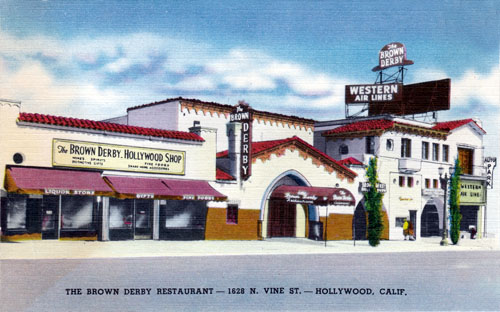
The one near Hollywood and Vine
The Brown Derby near Hollywood and Vine was situated in area from which many network radio shows were broadcast, so stars were always eating there. It was not uncommon for the cast of a program to do a performance for the East Coast, then repair to The Derby for food and libation before returning to the studio for the West Coast transmission. This caused the Brown Derby to be mentioned often on their shows. When TV shows began to emanate from some of the same studios in the fifties, there were occasional live remotes from that Brown Derby. The Ralph Edwards show, This is Your Life, always began by surprising some celebrity, often in a location very close to the studio from which the program was telecast. During the years that This is Your Life came from the Pantages Theater on Hollywood Boulevard, they often used the Derby, which was right around the corner. The night Edwards surprised Harold Lloyd there, Groucho Marx was in the next booth (on a break from filming You Bet Your Life at NBC’s nearby Sunset and Vine studio) and Marx began heckling Edwards as the latter attempted to hustle Mr. Lloyd across Vine Street. Well, who wouldn’t want to eat in a place where that kind of thing happened?
The Sunset-Vine Brown Derby also had a lovely banquet room and courtyard so it was the scene of many wrap parties and show biz press gatherings. All that “in” spot mystique spilled over to the Beverly Hills location and gave it a similar rep. On I Love Lucy, when Lucy, Fred and Ethel arrived in Hollywood and wanted to go somewhere to see the stars, they went to the Brown Derby…where Lucy caused a plate of food to be dumped on the head of Brown Derby regular William Holden. That was probably good for another five years of tourists flocking to the place.
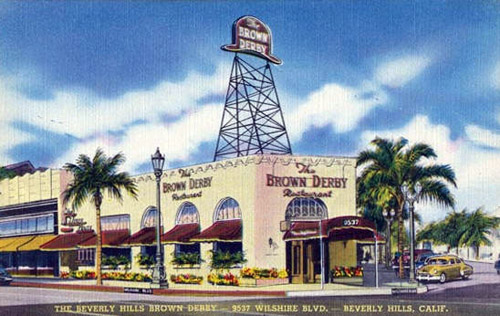
The one on Wilshire in Beverly Hills
Eventually though, business declined and Brown Derbies began closing down. I was an occasional patron of the Hollywood/Vine one in its last years, largely because I was working on a TV show that taped at the Sunset-Gower Studio a few blocks away. I recall being impressed with the history but unimpressed with the food…and somewhat bothered by the obsequious service. The host and waiters fawned over everyone who walked in the door like they were royalty and it seemed awfully antiquated and phony, at least to me. In any case, it was no longer the kind of place where Groucho and Bill Holden might drop by for a bite, so its main attraction was gone.
That Derby closed in ’85, the same year the Los Feliz branch turned into a night club. In the last few decades, much effort has gone into preserving the giant hat from the Wilshire location as a historical landmark. The only remaining Brown Derby is located at the Disney-MGM Studio theme park in Florida. I don’t know why they don’t buy the big hat and just ship it on down there.
Kowloon
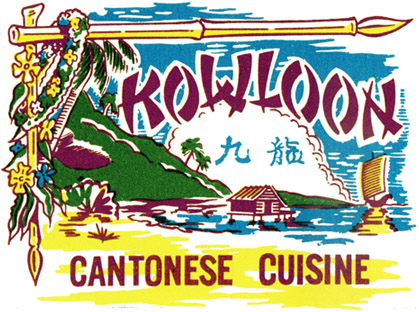
As I mentioned a few pages back in writing about a Chinese restaurant called Wan-Q, my family had its favorite place to get chow mein and it wasn’t Kowloon.
Kowloon was at 6124 W. Pico Boulevard, just east of La Cienega. It was across the street from where the post office there now is located. I remember it as a dark place with nice decor but they didn’t prepare the food the way Wan-Q did and so we didn’t like it and now that I think about it, I’m not sure why we even went there. I think it was my Aunt Dot’s penchant for trying new things that caused us to forsake a Chinese restaurant we loved and which was closer to us for one that was a bit farther away and an unknown quantity. To this day, if I find a place I like, I stick with it and don’t bypass it for something that, at best, might be just as good. I think this all flows from the lesson I learned when we tried Kowloon.
Villa Capri
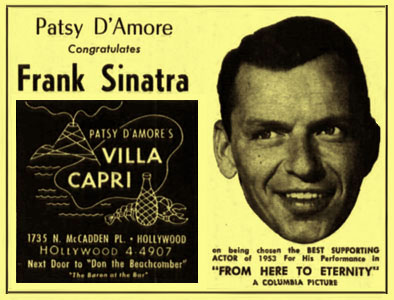
In 1939, the legendary restaurateur Pasquale “Patsy” D’Amore came to L.A. from New York and with his brother Franklyn, opened Casa D’Amore on Cahuenga Boulevard in Hollywood. There, they served the first pizza in Los Angeles to the likes of Frank Sinatra, Joe DiMaggio, Tommy Dorsey and Dick Powell.
In 1949, he opened Patsy D’Amore’s Pizza in the famous Farmers Market at Third and Fairfax. The place was such a success that a year later, he opened the Villa Capri on McCadden Street in Hollywood. In 1957, it relocated to a larger, plusher building a few blocks away at 6735 Yucca, one block north of Hollywood Boulevard. The new Villa Capri became a favorite of movie stars, including James Dean, Marilyn Monroe and Jimmy Durante. Durante was there so often that a private banquet room was named for him.
But the big star of the Villa Capri was Sinatra. That was, if you don’t count Patsy, who was much loved by the cliente. But with the Capitol Records building only a few blocks away, Frank practically used the restaurant as his clubhouse, dining there often and throwing lavish parties. When he recorded the song, “The Isle of Capri,” he snuck a mention of the Villa Capri into its lyrics. It is said that in 1960, when Sinatra threw his support behind John F. Kennedy for president, he held planning sessions there to figure out how to mobilize show business to help J.F.K.
D’Amore passed away in 1975, by which time the area around the Villa Capri had deteriorated. By then, for reasons unknown, Sinatra had shifted his main patronage to Matteo’s in Westwood. Joe Barbera (of Hanna-Barbera) used to lunch there almost every day, often taking Yours Truly. In 1982, shortly after it was used as a location for the movie Body Heat, the building was turned into a radio station and later an office complex before it was bulldozed in 2005. Still, the cuisine of the late Patsy D’Amore lives on. His family still owns and manages the Patsy’s Pizza stand in Farmers Market. A photo behind the counter proudly shows Patsy on the set of the movie Guys and Dolls, chatting with Sinatra.
R.J.’s for Ribs
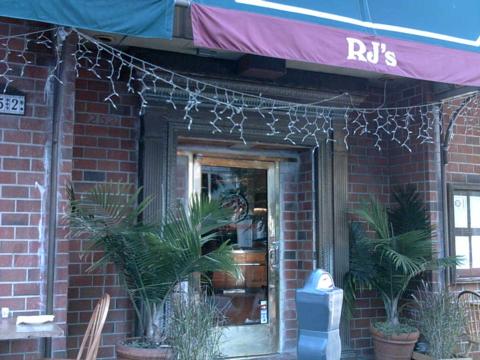
R.J.’s for Ribs was one of many restaurants opened in Southern California by a man named Bob Morris who was kind of the Johnny Appleseed of restaurants. Mr. Morris made his fame with Gladstone’s, the venerable seafood eatery out by the beach. Folks who went there when he ran it still talk about how great it was when it was wholly under his control. The current Gladstone’s bears little resemblance to that fine eatery but Morris now owns and operates the Paradise Cove Beach Cafe up in Malibu that more or less combines what was great about the old Gladstone’s with what was great about R.J.’s, which he operated in Beverly Hills at 252 N. Beverly Drive until 2006.
R.J.’s was a fun place with reasonable prices and the emphasis was, of course, on ribs. Whereas most rib joints specialize in pork, Gladstone’s did special things with the largest beef ribs I’d ever seen. Their pork ribs were fine — no complaints there — but the beef ribs were huge and meaty and tender. I usually opted for a combo of beef ribs and chicken. Their chicken was very, very good. Everything there was and so R.J.’s was very successful…and imitated. I’m not sure if Mr. Morris was involved in it but out on Ventura Boulevard in Encino, in a building that’s now a Buca di Beppo, there was a restaurant called Adam’s Ribs that was a near-clone. It was not quite as good but it came close.
Like most Bob Morris restaurants, R.J.’s had…
- A very, very long salad bar with items you usually don’t see in a salad bar. I brought vegetarian friends there and they were very happy to graze while I gnawed on animal flesh.
- Sawdust on the floor. And interesting things on the walls, mainly photos of old Los Angeles. Once, I spotted a photo I liked so much (it was of a fave childhood haunt) that I called Mr. Morris’s office and they gave me the name of the photographer/archivist they got them from. Then I called him and ordered a print.
- The Bob Morris Clam Chowder. Folks raised in New England would sometimes say, “That’s not how clam chowder’s supposed to be. It’s too thick.” And it was thick. But not having been raised in New England, I thought it was the best white clam chowder I ever had. You can still get it at his current establishment.
- Monster-sized desserts. People would order the chocolate cake and be stunned at what they got: A slice big enough to carve up and share with six people, with gobs of whipped cream on the side. It was also unbelievably rich and moist. Once when I was there with one person, we didn’t want to order the cake because we weren’t going home after. The people at the next table heard us and handed us the unconsumed cake they were left with after stuffing themselves. We ate all we could and then handed it off to strangers at yet another table. I have a feeling they weren’t the last in that food chain.
- Decorative “to go” wrappings. It wasn’t just the cake that most folks took home to eat the next day (and maybe the next and the next…) I always took home ribs and/or chicken from my colossal-sized entree. R.J.’s was known for huge portions and few could finish them on the premises. The bus boys were all trained to wrap your overage in gold aluminum foil and then to sculpt the package into a swan or other artistic creation. It was like making balloon animals with your leftovers. I used to challenge them: “Hey, how about an aardvark? Or a puma?”
- New items. I went to R.J.’s about twice a month and there always seemed to be something on the menu that hadn’t been there before. Once, it was something called The 1,000 Year Old Baked Potato. It was a huge potato that was served at your table in a crockery shell. Allegedly, it had been encased like a mummy in a shell of brick that was stamped and numbered, then baked underground in a pit for ten centuries or something. Your server broke open the shell with a little hammer and then served you your potato with a tray of about a dozen condiments including caviar and real, just-cooked bacon bits.
- Other little touches. Coffee was served with a side cup of whipped cream and another of chocolate morsels. The chowder came with a soup mandel, which is kind of like a big Jewish crouton. Sometimes, there was a little appetizer bar of cheese and crackers and other goodies to munch on. and there were always open bins of free peanuts while you waited for your table. On a Friday, Saturday or Sunday evening (sometimes on a weeknight), that could be a long wait.
That was the main downside of R.J.’s, at least at the peak of its popularity: The wait. That was a problem out at the old Gladstone’s, too. An 8 PM reservation meant you started waiting for a table at 8 PM and were fortunate to be seated by, say, 8:45. Even though they provided snacks, it could be frustrating and there was the clear and present feeling that it was deliberate; that they wanted you to spend heavily at the bar before they’d seat you. The bar, like everything else there except the prices, was huge. They’d boast of having 600 different beers or 800 different beers…the number kept changing but it was always believable, given what you saw there. There were as many non-beer alcoholic beverages, as well. Eventually though, you’d get your table and about the time your clam chowder arrived, you’d start feeling it was worth the wait. In case you can’t tell, I really liked this place.
And there was a way around the wait, sort of. I had this friend named Stanley Ralph Ross, a prolific TV writer and occasional restaurant critic. Stanley was a friend of Bob Morris…one who claimed to have suggested the name of Gladstone’s. (Given Stanley’s tendency to exaggerate, it wouldn’t surprise me if Mr. Morris did not agree.) When I told him of an excruciatingly long wait at R.J.’s one night, Stanley said, “You need a Farkleberry Card,” and before I could ask what the hell that was, Stanley was on the phone to Bob Morris’s office, convincing some nice lady there to send me one. It turned out to be a blue plastic card not unlike a credit card in look and feel but it didn’t buy anything. Instead, you flashed it quietly to the hostess to tell her you were some sort of privileged friend of R.J.’s…I guess. It was supposed to get you a table swiftly (or even sans reservation) but I’m not sure it ever sped the seating process and I never dared go there without a reservation. Still, I told myself after waiting just under an hour for a table, “Just think how long it would take without the card.” And I did feel privileged in some odd way.
Eventually, R.J.’s went away in stages. Morris sold it to others and they took it downhill farther and faster than the folks who’d ruined Gladstone’s. The last time I was there, they had notices up that they were moving, location unspecified. On the sly, the hostess told me the owners had just signed a lease on a place on Santa Monica Boulevard near La Cienega and that they’d be up and running there in less than two months. This was in 2006 and I’m starting to get the feeling that ain’t gonna happen.
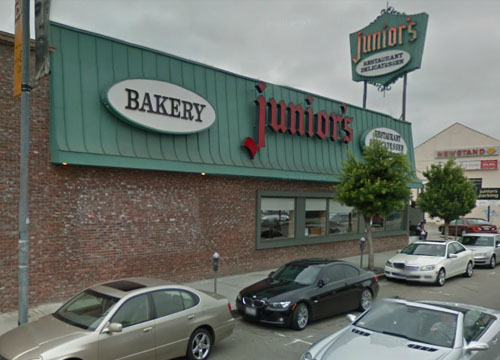
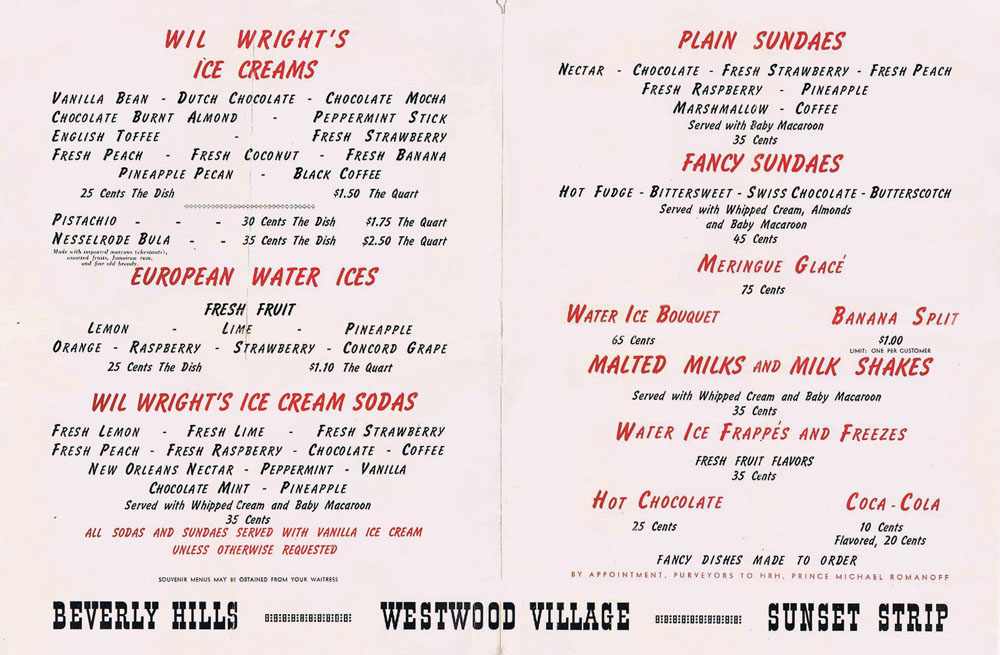
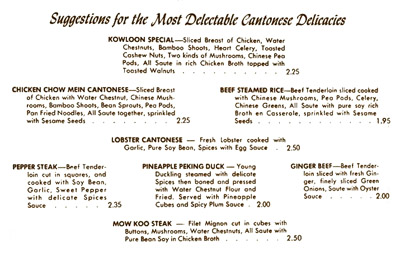






Recent Comments